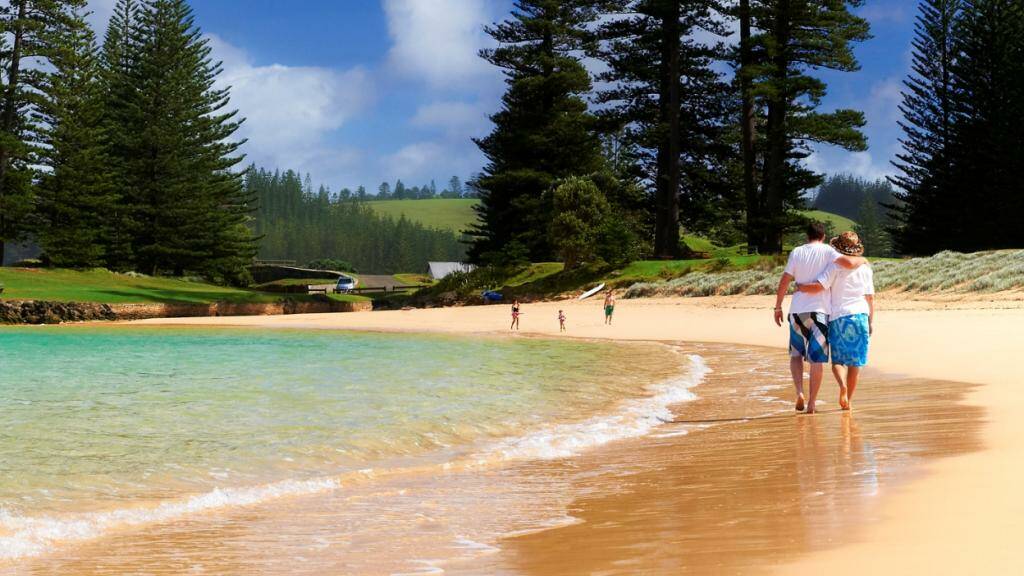“Beautiful, isn’t it?” The man beside me in seat 4A stares out the window as Norfolk Island explodes beneath us with the sunset. The island’s iconic Norfolk pines drip with orange, beaches look crimson-red, even the sea seems an odd mix of mauve and toffee-brown.
Create a free account to read this article
$0/
(min cost $0)
or signup to continue reading
As I mutter a polite response, I notice his uniform. “Hang on, if you’re the pilot,” I ask, “who’s flying this plane?” He lets out a chuckle. “Don’t worry, you’ll get down safely.” We do – I hasten to add – get down safely; and Norfolk Island is – as the pilot says – beautiful, but sitting beside the pilot in the back of the plane as you prepare for touchdown is merely a warm-up for the unique adventures of a Norfolk Island holiday.
Consider, for instance: that many Norfolk Islanders are descendants of the Bligh mutineers (those British sailors who stole Captain William Bligh’s ship, HMS Bounty, from him in 1789 off Tahiti and sailed for Pitcairn Island, casting Bligh adrift in a lifeboat). Or else they’re married to a descendant – and most take turns to tell me that their ancestor was actually the most important figure in the mutiny.
Queen Victoria gave the descendants of the Bligh mutiny possession of the abandoned penal settlement of Norfolk Island in 1856 when overcrowding became an issue on Pitcairn Island. So a Quintal descendant will tell you that able-bodied seaman Matthew Quintal was just as integral a figure as chief mutineer Fletcher Christian in the whole saga. Whereas the Christian clan mostly just look smug because Hollywood’s hottest heart-throbs: Mel Gibson, Clark Gable and Marlon Brando amongst them, were chosen to represent their great-great-great-great-great-great grandpa.
Norfolk Islanders also have their own language, one of the least practised languages on Earth: a bizarre mix of 18th-century seafarer’s English and Tahitian. Norfolk Island is also one of the only places outside America where Thanksgiving Day is celebrated each year with a public holiday (thanks to a history rich with American whalers).
If you don’t study the history of Norfolk Island before you go, then you’re missing a lot of the attraction for going there. A few hours of casual googling should be a prerequisite for every visitor.

This was the site of the Commonwealth’s harshest penal settlement. It’s hard to envision the human misery that took place here – although the shell of the prison still stands, along with the guard’s and officer’s quarters on the beautiful shores of the capital, Kingston – but the scale of suffering seems obscene as I watch children frolic in the pretty lagoons and families picnic in the park beside the grounds of the prison.
You’ll also have to learn some very strange road rules; the first is imperative: give way to the island’s cows, they wander the island like they own the place. Despite their complete disregard for road rules, the onus is on you, not the cows, to give way. Should you hit one, legend has it old English law states you must pay the farmer what the animal would’ve been worth at the butchers. You’re also supposed to wave to everyone, a tough call for city drivers.
But if all of this suggests an island full of bumpkins, that’s where you’re mistaken. Once regarded as a holiday haven for ‘the newly wed, or the nearly dead’, these days Norfolk Island offers travellers a lot more.
Adventure lovers have a lot to sample. There are hiking trails which take you through virgin forest and high above the ocean on trails etched along the island’s craggy coastline. You can also mountain bike some fairly demanding mountain trails. I find empty walking trails which take me down to protected rock pools where I swim in clear warm water. Another day I sea kayak along Norfolk Island’s own 12 Apostles: huge rock stacks that jut from the sea along the island’s rugged northern coastline.
Then there’s the surf that pounds the island’s coastline. Norfolk Island has to be the only place in the world surfers leave their boards on the beach between surfs (try that at Bondi). There are only a handful of surfers on the island so the waves are never crowded, and there’s a combination of challenging reef breaks, and sand-bottom breaks, so you don’t have to be Kelly Slater to survive here.
Norfolk Island is also a world-class destination for divers with over 30 dive sites, in water with over 20 metres of visibility, that’s amongst the cleanest on the planet. There’s virtually no pollution since Norfolk Island is 1400 kilometres from the nearest major landfall (Australia’s east coast), and there’s no fresh-water run-off.
And the fishing here is legendary – there’s no commercial fishing industry, so the waters teem with deep-water species. Little wonder then that one in four people on Norfolk Island own a fishing boat: that’s 500 boats for 2000 people.
Although, that’s not to say they all love to deep-sea fish. “Some blokes on this island get seasick,” a fisherman tells me one day. “They’re the blokes you’ll see fishing from the rocks and off the beaches, poor buggers.” Ernest Hemingway’s revered fishing novel, Old Man And The Sea, was actually on the local high school’s required reading list.
The golf course here entices me almost as much as the sea. It sits astride the coastline, just beyond the convict ruins, and is brutal for those who slice (unless you’re good at looking for your ball in the sea). It’s a great way to meet some of the island’s crustiest characters.
You can also visit coffee plantations, even a winery (Two Chimneys) and you can see the homestead where famed Aussie author Colleen McCullough lived for 36 years. While this has to be the ultimate family destination – you won’t find a safer place on Earth, here the hire car company advise me to never lock up my car, and accommodation too comes without keys (you can get keys if you’re too used to the city) – there’s enough sophistication these days to suit even the most seasoned traveller.
I’ve been coming here for 15 years and the food scene continues to change with the times. In fact, Norfolk Island’s fast earning a reputation as a foodie destination, with everything produced here from cheese to Norfolk Blue, a unique variety of beef you’ll only find here. Each year, the best of the produce is on display at Norfolk’s annual food festival (Taste Food Festival, 23-26 November).
I take a tour of the Hilli Goat to sample cheeses on a property overlooking the sea, then drive a little further around the coastline for Norfolk Island’s best-positioned restaurant, Bedrock Tea Gardens (try the fish feast here in the evenings).
The views at some of the island’s cafes and restaurants dazzle, but my favourite spot to eat remains Dino’s at Bumboras – it’s set in a convict-built farmhouse crafted from local pine and sandstone, and it feels just like you’ve been invited to dinner at a local’s home.
What I like most about visiting Norfolk Island is you can detach yourself from life as much as you want to here; I can stay in a remote cottage, swim on deserted beaches, wander through bushland and enjoy sunsets off lonely coastal cliffs while barely seeing another person. Or if you’d prefer, Norfolk Island is home to some of the friendliest folk in the Pacific who’ll take you in like long lost family. The choice is entirely yours (just watch out for those cows).
Take me there
Fly: Air New Zealand flies direct to Norfolk Island from Sydney three times a week, and from Brisbane twice a week.
Explore more: norfolkisland.com.au
5 Australian island getaways
Not content with being an island beauty in its own right, Australia is also blessed with some stunning isles offshore. Here’s five more to consider for your next holiday.
Hamilton Island, Qld
As the largest inhabited island in the Whitsundays, Hamilton Island has its own airport (so it’s easy to get to), some of Australia’s fanciest resorts (such as Qualia) and a bustling social scene.
Lord Howe Island, NSW
Protected under World Heritage listing, Lord Howe is one of the world’s most pristine islands. With room for just 400 guests, it’s home to the world’s southern-most coral reef, lagoons, stunning beaches and mountain hikes. It’s Norfolk Island’s closest neighbour.
Lizard Island, Qld
Home to just one resort, Lizard Island has the northern-most island resort of the Great Barrier Reef. Fly here in an hour from Cairns and lose yourself amongst the coral and beaches on an island that is totally detached from modern life.
Kangaroo Island, SA
Australia’s second-largest island, KI in South Australia, has 500 kilometres of coastline south that’s home to everything from sea lions to turtles. While its beaches are world-revered, land activities are just as tempting. Scorched by fires, Kangaroo Island is bouncing back.
Hayman Island, Qld
Long acknowledged as one of the country’s most luxurious island escapes, Hayman is where rock stars and movie heroes come to hide. Nestled within the 74 islands of the Whitsundays, it’s the ultimate island chill-out.




